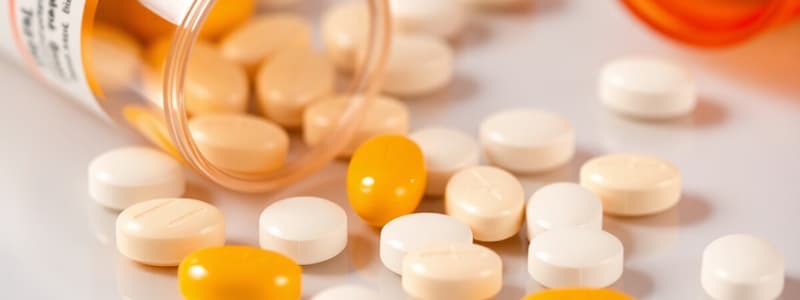Podcast
Questions and Answers
What is the primary mechanism of action for the diuretic drug mentioned in the initial section of the text?
What is the primary mechanism of action for the diuretic drug mentioned in the initial section of the text?
The diuretic drug inhibits the sodium-potassium-chloride cotransporters (NKCC2) in the nephron.
What are two common indications for using the diuretic described in the text?
What are two common indications for using the diuretic described in the text?
Two common indications are hypertension and treatment for edema.
Identify three potential side effects of the diuretic drug discussed in the text.
Identify three potential side effects of the diuretic drug discussed in the text.
Potential side effects include increased urination, electrolyte disturbance, and dehydration.
What is the mechanism of action for Sildenafil (Revatio, Viagra)?
What is the mechanism of action for Sildenafil (Revatio, Viagra)?
List two therapeutic uses of Sildenafil.
List two therapeutic uses of Sildenafil.
What is the recommended route of administration for Sildenafil?
What is the recommended route of administration for Sildenafil?
What are two potential side effects of Sildenafil?
What are two potential side effects of Sildenafil?
What is the primary indication for using Paracetamol (acetaminophen)?
What is the primary indication for using Paracetamol (acetaminophen)?
What is the mechanism of action of dexamethasone?
What is the mechanism of action of dexamethasone?
What are the two common routes of administration for dexamethasone?
What are the two common routes of administration for dexamethasone?
List three common side effects associated with dexamethasone use.
List three common side effects associated with dexamethasone use.
What is the primary mechanism of action for furosemide (Lasix)?
What is the primary mechanism of action for furosemide (Lasix)?
Name four conditions that commonly respond well to treatment with ACE inhibitors (ACEi).
Name four conditions that commonly respond well to treatment with ACE inhibitors (ACEi).
Describe two primary mechanisms by which spironolactone exerts its therapeutic effects.
Describe two primary mechanisms by which spironolactone exerts its therapeutic effects.
Compare and contrast the indications for use between ACE inhibitors and spironolactone.
Compare and contrast the indications for use between ACE inhibitors and spironolactone.
What are two common side effects associated with ACE inhibitor use?
What are two common side effects associated with ACE inhibitor use?
Name three different conditions or situations that may benefit from the use of methylprednisolone.
Name three different conditions or situations that may benefit from the use of methylprednisolone.
Explain how the renin-angiotensin-aldosterone system (RAAS) is involved in the regulation of blood pressure.
Explain how the renin-angiotensin-aldosterone system (RAAS) is involved in the regulation of blood pressure.
What are the primary side effects associated with increasing the dose of long-acting insulin at night?
What are the primary side effects associated with increasing the dose of long-acting insulin at night?
How does thyroid hormone affect the metabolic rate in different tissues?
How does thyroid hormone affect the metabolic rate in different tissues?
What is the role of Levothyroxine in treating hypothyroidism?
What is the role of Levothyroxine in treating hypothyroidism?
Describe the conversion process of T4 in the body.
Describe the conversion process of T4 in the body.
List two common side effects of Levothyroxine.
List two common side effects of Levothyroxine.
What is the main function of corticosteroids in the body?
What is the main function of corticosteroids in the body?
What are common routes of administration for Levothyroxine?
What are common routes of administration for Levothyroxine?
Identify one side effect from the use of corticosteroids.
Identify one side effect from the use of corticosteroids.
Describe the primary role of insulin in the body and how it affects glucose metabolism.
Describe the primary role of insulin in the body and how it affects glucose metabolism.
Why is insulin necessary for individuals diagnosed with type 1 diabetes mellitus?
Why is insulin necessary for individuals diagnosed with type 1 diabetes mellitus?
What are the different routes of administration for insulin?
What are the different routes of administration for insulin?
Describe the 'honeymoon phase' in type 1 diabetes mellitus and explain its significance.
Describe the 'honeymoon phase' in type 1 diabetes mellitus and explain its significance.
How can ketoacidosis at presentation affect the likelihood of a remission phase in type 1 diabetes mellitus?
How can ketoacidosis at presentation affect the likelihood of a remission phase in type 1 diabetes mellitus?
Explain the concept of the Somogyi phenomenon and describe its possible treatment.
Explain the concept of the Somogyi phenomenon and describe its possible treatment.
What is the dawn phenomenon and how does it differ from the Somogyi phenomenon?
What is the dawn phenomenon and how does it differ from the Somogyi phenomenon?
What is a potential treatment for the dawn phenomenon?
What is a potential treatment for the dawn phenomenon?
Flashcards
Furosemide (Lasix): Mechanism of Action
Furosemide (Lasix): Mechanism of Action
Furosemide is a diuretic that works by blocking the reabsorption of sodium and chloride in the kidneys, leading to increased urine production.
Furosemide (Lasix): Indications
Furosemide (Lasix): Indications
Furosemide is used to treat fluid build-up (edema) in various conditions, including heart failure, liver disease, and kidney disease. It also helps lower blood pressure.
Furosemide (Lasix): Route of Administration
Furosemide (Lasix): Route of Administration
Furosemide is typically administered orally as a tablet or solution. In some cases, it can also be given intravenously.
Furosemide (Lasix): Side Effects
Furosemide (Lasix): Side Effects
Signup and view all the flashcards
Role of Thyroid Hormone in Development
Role of Thyroid Hormone in Development
Signup and view all the flashcards
What is Levothyroxine?
What is Levothyroxine?
Signup and view all the flashcards
How does Levothyroxine Work?
How does Levothyroxine Work?
Signup and view all the flashcards
What are Corticosteroids?
What are Corticosteroids?
Signup and view all the flashcards
What are the Properties of Corticosteroids?
What are the Properties of Corticosteroids?
Signup and view all the flashcards
Examples of Corticosteroids
Examples of Corticosteroids
Signup and view all the flashcards
How is Levothyroxine Administered?
How is Levothyroxine Administered?
Signup and view all the flashcards
What are Potential Side Effects of Levothyroxine?
What are Potential Side Effects of Levothyroxine?
Signup and view all the flashcards
What is insulin?
What is insulin?
Signup and view all the flashcards
What is Type 1 Diabetes?
What is Type 1 Diabetes?
Signup and view all the flashcards
What is Type 2 Diabetes?
What is Type 2 Diabetes?
Signup and view all the flashcards
What is the honeymoon phase in Type 1 diabetes?
What is the honeymoon phase in Type 1 diabetes?
Signup and view all the flashcards
What is the Somogyi phenomenon?
What is the Somogyi phenomenon?
Signup and view all the flashcards
What is the Dawn phenomenon?
What is the Dawn phenomenon?
Signup and view all the flashcards
How is insulin delivered?
How is insulin delivered?
Signup and view all the flashcards
How does insulin affect the liver?
How does insulin affect the liver?
Signup and view all the flashcards
Loop Diuretics
Loop Diuretics
Signup and view all the flashcards
Congestive Heart Failure
Congestive Heart Failure
Signup and view all the flashcards
Sildenafil (Viagra)
Sildenafil (Viagra)
Signup and view all the flashcards
Nonsteroidal Anti-inflammatory Drug (NSAID)
Nonsteroidal Anti-inflammatory Drug (NSAID)
Signup and view all the flashcards
Paracetamol (Acetaminophen)
Paracetamol (Acetaminophen)
Signup and view all the flashcards
Ibuprofen
Ibuprofen
Signup and view all the flashcards
Diclofenac
Diclofenac
Signup and view all the flashcards
Increased Urination (Diuresis)
Increased Urination (Diuresis)
Signup and view all the flashcards
Study Notes
Insulin
- Insulin is a peptide hormone made by beta cells in the pancreatic islets.
- It's the primary anabolic hormone in the body, regulating carbohydrate, fat, and protein metabolism.
- Insulin promotes glucose uptake by liver, fat, and muscle cells.
- Absorbed glucose is stored as glycogen via glycogenesis or converted to fat (triglycerides) via lipogenesis.
- Glucose production and secretion by the liver are significantly inhibited by high insulin concentrations.
Insulin Indications
- Primarily used to replace missing insulin secretion in type 1 diabetes.
- Also used in type 2 diabetes to supplement insufficient insulin.
Insulin Routes of Administration
- Injections (subcutaneous, intravenous, intramuscular, intraperitoneal)
- Inhaler.
- Personal insulin pump.
Insulin Regimens
- 50% of daily dose is rapid-acting insulin (e.g., NovoRapid)
- Delivered in pre-meal boluses.
- Remaining 50% is long-acting insulin (e.g., Lantus).
- Administered as a single evening injection.
Partial Remission (Honeymoon Phase) in Type 1 Diabetes
- Insulin requirements may temporarily decrease after starting treatment.
- Defined as requiring less than 0.5 units of insulin per kg of body weight per day, with an HbA1c < 7%.
- Ketoacidosis at diagnosis, and younger age, are associated with a reduced likelihood of remission.
- Important to advise patients and families about the temporary nature of this phase to avoid false hope of spontaneous recovery.
- Treatment often involves reducing insulin dosage accordingly.
Somogyi Phenomenon
- Children with high doses of bedtime long-acting insulin may experience hypoglycemia late at night (3–4 AM).
- This triggers the release of counter-regulatory hormones, leading to rebound hyperglycemia in the early morning.
- Treatment involves reducing the dose of long-acting insulin at night.
Dawn Phenomenon
- Children with normal insulin doses, experiencing normal overnight glucose levels, sometimes present with early morning hyperglycemia due to a rise in counter-regulatory hormones.
- Treatment: Increasing the dose of long-acting insulin at night.
Insulin Side Effects
- Hypoglycemia.
- Hypokalemia.
- Weight gain.
- Hypersensitivity reactions (anaphylaxis).
- Injection site complications (lipodystrophy, redness, itching, infection).
Thyroid Hormone (Thyroxine - T4)
- The thyroid hormone, primarily T4, controls the metabolic rate of all cells in the body.
- Important for fetal and newborn growth and development, particularly affecting bones and the brain.
- In adults, this hormone helps maintain brain function, food metabolism, and body temperature.
Levothyroxine
- Synthetic form of T4.
- Used as a replacement for T4 in deficiency syndromes, such as hypothyroidism.
- A tetra-iodo-tyrosine derivative.
Levothyroxine Mechanism of Action
- Acts in a similar manner to the naturally produced thyroid hormone.
- T4 is converted to the active form, T3, in the liver and kidneys.
- Levothyroxine simulates the action of natural thyroxine.
Levothyroxine Route of Administration
- Oral (tablets, capsules, powder).
- Intravenous (vial).
Levothyroxine Side Effects
- Cardiovascular (palpitations).
- Nervous system (nervousness, headache, insomnia).
- Skin (sweating).
- Endocrine (irregular hyperglycemia, hypo-cholesterolemia).
- Gastrointestinal (nausea, vomiting, diarrhea).
- Metabolic (weight loss, heat intolerance).
Steroids (Hydrocortisone & Prednisone)
- Steroid hormones, produced by the adrenal cortex, regulate stress response, inflammation, and protein/carbohydrate metabolism.
- Synthetic analogues of these hormones are also used clinically.
Steroid Mechanism of Action
- Steroids primarily enter cells and bind to cytosolic receptors that transport them to the nucleus.
- The steroid-receptor complex alters gene expression.
- Tissue-specific responses are a result of the diverse protein regulators present in each tissue type, managing interactions between the hormone-receptor complex and specific response elements.
Steroid Routes of Administration
- Parenteral (IV, IM, intra-articular).
- Oral.
- Inhalation.
- Topical.
- Rectal.
Steroid Indications
- Arthritis and Systemic Lupus Erythematosus (SLE).
- Inflammatory bowel disease (Crohn's disease, ulcerative colitis).
- Blood disorders (Idiopathic Thrombocytopenic Purpura - ITP).
- Asthma.
- Adrenocortical insufficiency.
- Nephrotic syndrome.
- Acute childhood leukemia.
- Post-transplant immunosuppression.
Steroid Side Effects
- Osteoporosis.
- Hypertension.
- Psychosis, irritability.
- Hyperglycemia.
- Impaired wound healing.
- Depressed immunity, higher susceptibility to infection.
- Skin drying, thinning.
Dexamethasone & Methylprednisolone
- Potent glucocorticoids with minimal mineralocorticoid activity.
- Used for their potent anti-inflammatory properties by inhibiting phospholipase A2, decreasing inflammatory cytokines, and increasing capillary permeability.
Dexamethasone & Methylprednisolone Mechanism of Action
- Act by blocking various inflammatory pathways, primarily by inhibiting the synthesis and activity of prostaglandins.
Dexamethasone & Methylprednisolone Indications
- Respiratory issues (airway edema, croup, respiratory distress syndrome).
- Adrenal cortical hyperfunction tests.
- Immune thrombocytopenic purpura (ITP).
- Central nervous system conditions (meningitis, cerebral edema with space-occupying lesions, spinal cord compression).
- Inflammation in general
Dexamethasone & Methylprednisolone Routes of Administration
- Oral (tablets, syrup).
- Intravenous (IV).
- Intramuscular (IM).
Dexamethasone & Methylprednisolone Side Effects
- Hiccups.
- Gastric upset.
- Easy bruising.
- Sleep disturbances.
- Weight gain.
Methylprednisolone Mechanism of Action
- A potent glucocorticoid with minimal mineralocorticoid activity.
- Inhibits inflammatory cytokine cascades and T cell activation.
- Decreases immune cell extravasation into the central nervous system.
Methylprednisolone Indications
- Acute Asthma
- Lupus nephritis
- Acute exacerbation of multiple sclerosis (MS).
- Autoimmune inflammatory disorders (e.g., juvenile idiopathic arthritis, inflammatory bowel disease (IBD), connective tissue disorders, systemic lupus erythematosus).
Methylprednisolone Routes of Administration
- Oral tablets.
- Intravenous (IV) injections.
- Intramuscular (IM) injections.
Methylprednisolone Side Effects
- Nausea and/or vomiting.
- Heartburn.
- Headache.
- Sweating.
- Acne.
- Insomnia.
Furosemide (Lasix)
- A loop diuretic.
- Blocks sodium and chloride reabsorption, as well as increasing the excretion of water and electrolytes (sodium, chloride, potassium, magnesium, calcium, hydrogen).
Furosemide Indications
- Hypertension.
- Edema (acute pulmonary edema, congestive heart failure, hepatic cirrhosis complicated by ascites, nephrotic syndrome).
- Hypercalcemia - increasing calcium excretion.
- Hyperkalemia - increasing potassium excretion.
- Acute renal failure.
Furosemide Routes of Administration
- Oral tablets.
- Intravenous (IV) injections.
- Intramuscular (IM) injections.
Furosemide Side Effects
- Increased urination, thirst, dehydration.
- Electrolyte imbalances.
- Diarrhea, nausea, vomiting, loss of appetite.
- Rapid weight loss.
- Fever, itching or rash - allergic reactions.
- Ototoxicity.
Sildenafil (Revatio, Viagra)
- A phosphodiesterase 5 inhibitor.
- Enhances the effects of nitric oxide, leading to relaxation of smooth muscle in the corpus cavernosum.
Sildenafil Indications
- Pulmonary arterial hypertension.
- Erectile dysfunction.
Sildenafil Routes of Administration
- Oral.
- Injectable.
Sildenafil Side Effects
- Headache.
- Flushing.
- Impaired vision.
- Myocardial infarction (MI).
- Ventricular arrhythmias.
Paracetamol (Acetaminophen)
- Analgesic (mild to moderate pain relief) and antipyretic (fever reducer).
- Primarily used for pain relief associated with headache, muscle ache, sore throat, back pain, toothache, and menstrual cramps.
- Works by blocking the formation of prostaglandins in the central nervous system.
Paracetamol Routes of Administration
- Oral (syrup, tablets, chewable tablets).
- Rectal (suppositories).
- Intramuscular (IM) injection.
- Intravenous (IV) infusion.
Paracetamol Side Effects
- Very safe, but overdoses can lead to potentially serious liver damage (hepatotoxicity).
- Allergy (very rare).
Ibuprofen
- Non-selective COX inhibitor.
- Anti-inflammatory, analgesic (pain reliever), and antipyretic.
Ibuprofen Mechanism of Action
- Inhibits the enzyme cyclooxygenase (COX), decreasing prostaglandin synthesis; primarily COX-1 and COX-2.
Ibuprofen Routes of Administration
- Oral (tablets, syrup, capsules, chewable tablets).
- Rectal suppositories.
- Topical.
- Intravenous (IV infusion).
Ibuprofen Side Effects
- Constipation/diarrhea.
- Potential kidney damage.
- Stomach pain/bloating.
- Dizziness.
- Nervousness.
- Ringing in the ears.
Diclofenac
- Non-steroidal anti-inflammatory drug (NSAID); inhibits prostaglandin synthesis via COX-1 and COX-2 inhibition.
Diclofenac Indications
- Pain relief.
- Fever reduction.
Diclofenac Routes of Administration
- Oral (tablets, solutions).
- Injections.
- Gels.
Diclofenac Side Effects
- Stomach ache/gastric ulceration.
- Elevated serum aminotransferase levels.
- Renal impairment.
- Fluid retention, leading to hypertension.
Studying That Suits You
Use AI to generate personalized quizzes and flashcards to suit your learning preferences.




